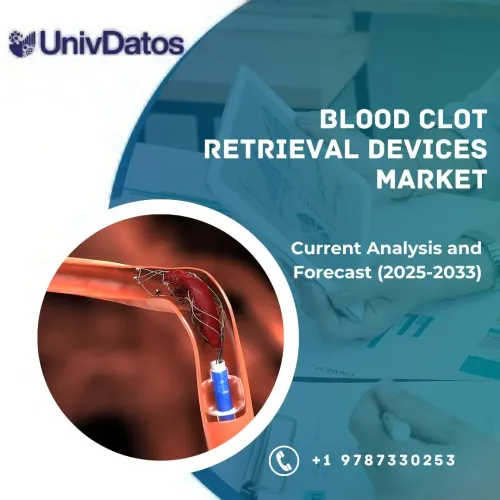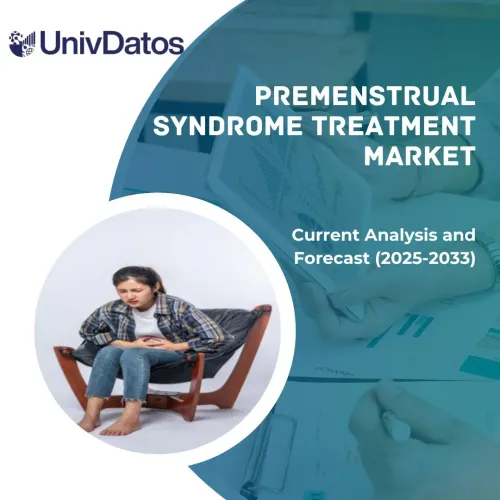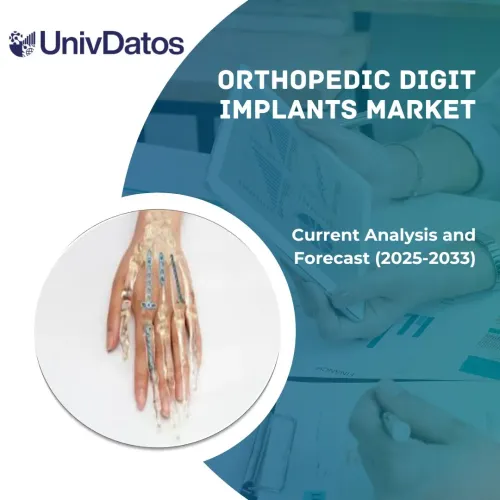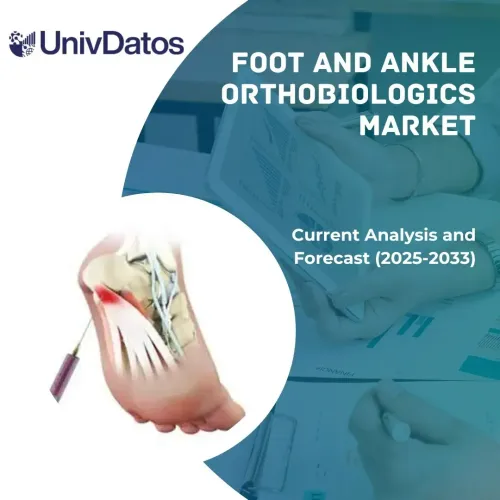- Trang chủ
- Về chúng tôi
- Ngành
- Dịch vụ
- Đọc
- Liên hệ với chúng tôi
Thị trường Thiết bị Kiểm tra Khả năng sinh sản: Phân tích Hiện tại và Dự báo (2022-2028)
Tập trung vào Sản phẩm (Bộ dụng cụ dự đoán rụng trứng, Máy theo dõi khả năng sinh sản, Sản phẩm kiểm tra khả năng sinh sản nam giới); Phương thức mua (Dựa trên đơn thuốc, Không cần kê đơn, Trực tuyến); Ứng dụng (Thiết bị kiểm tra khả năng sinh sản nữ giới, Thiết bị kiểm tra khả năng sinh sản nam giới); Người dùng cuối (Cơ sở chăm sóc tại nhà, Bệnh viện & Phòng khám hiếm muộn, Và những cơ sở khác); Khu vực/Quốc gia
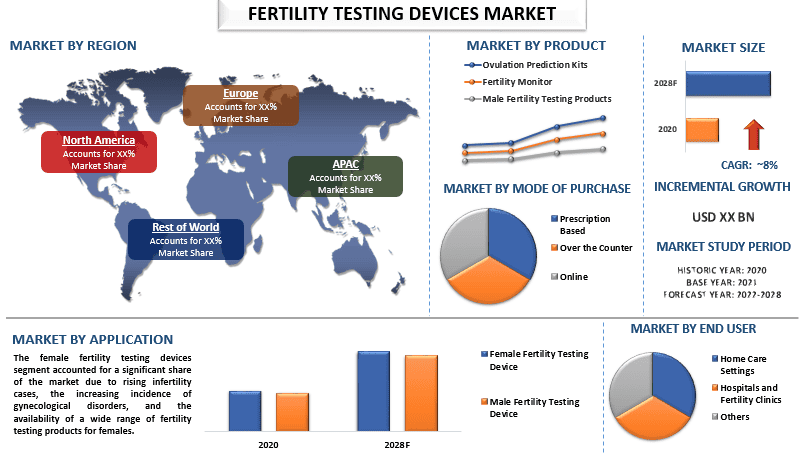
Thị trường Thiết bị Kiểm tra Khả năng Sinh sản Toàn cầu dự kiến sẽ tăng trưởng với tốc độ đáng kể khoảng 8% trong giai đoạn dự báo. Điều này chủ yếu là do sự tiến bộ nhanh chóng của công nghệ và sự gia tăng độ tuổi mang thai lần đầu, và sự sẵn có của các xét nghiệm chẩn đoán được tổ chức lại ít tốn thời gian hơn thay cho các xét nghiệm trong phòng thí nghiệm chịu trách nhiệm cho sự tăng trưởng thị trường của thị trường thiết bị kiểm tra khả năng sinh sản. Hơn nữa, việc ngày càng áp dụng các sản phẩm xét nghiệm chẩn đoán tại nhà đóng góp đáng kể vào thị trường thiết bị xét nghiệm. Theo CDC, vào năm 2019, khoảng 6% phụ nữ đã kết hôn trong độ tuổi 15-44 ở Hoa Kỳ không thể thụ thai sau một năm cố gắng. Hơn nữa, sự gia tăng dân số già của đất nước cũng góp phần thúc đẩy thị trường thiết bị kiểm tra khả năng sinh sản. Nhu cầu về các sản phẩm thiết bị kiểm tra khả năng sinh sản cũng tăng lên do tỷ lệ mắc các bệnh lý như mất cân bằng nội tiết tố ở nữ giới ngày càng gia tăng như chảy máu không đều và nhiều, sảy thai không thể mô tả và các bất thường của tử cung chịu trách nhiệm cho việc sử dụng quá nhiều thiết bị kiểm tra khả năng sinh sản và đóng góp đáng kể vào thị trường cho các thiết bị này. Do đó, thị trường thiết bị kiểm tra khả năng sinh sản dự kiến sẽ chứng kiến sự tăng trưởng đáng kể trong giai đoạn dự báo.
Church & Dwight Co. Inc., Geratherm Medical A.G., Prestige Consumer Healthcare Inc., Swiss Precision Diagnostics GmbH, Procter & Gamble Co., Abbott Laboratories, Piramal Enterprises Ltd., Quidel Corporation, Alfa Scientific Designs Inc., AdvaCare Pharma là một số công ty chủ chốt trên thị trường. Một số hoạt động M&A cùng với quan hệ đối tác đã được thực hiện bởi những người chơi này để tạo điều kiện cho khách hàng các sản phẩm/công nghệ công nghệ cao và sáng tạo.
Thông tin chi tiết được trình bày trong báo cáo
“Trong số các sản phẩm, danh mục bộ dụng cụ dự đoán rụng trứng sẽ chứng kiến CAGR đáng kể trong giai đoạn dự báo”
Dựa trên sản phẩm, thị trường được phân khúc thành bộ dụng cụ dự đoán rụng trứng, thiết bị theo dõi khả năng sinh sản và các sản phẩm kiểm tra khả năng sinh sản của nam giới. Danh mục bộ dụng cụ dự đoán rụng trứng sẽ chứng kiến CAGR đáng kể trong giai đoạn dự báo do sự thâm nhập ngày càng tăng của thiết bị kiểm tra khả năng sinh sản. Khi được thực hiện đúng cách, các xét nghiệm rụng trứng có độ chính xác khoảng 99% trong việc phát hiện sự tăng vọt LH trước khi rụng trứng
“Trong số các phương thức mua hàng, hình thức mua không cần kê đơn sẽ chiếm thị phần đáng kể trên thị trường vào năm 2020”
Trên cơ sở phương thức mua hàng, thị trường được phân loại thành các sản phẩm dựa trên đơn thuốc, không cần kê đơn và trực tuyến. Trong số đó, hình thức mua không cần kê đơn sẽ chiếm một thị phần đáng kể trên thị trường vào năm 2020. Điều này chủ yếu là do.
“Trong số các ứng dụng, hình thức mua không cần kê đơn sẽ chiếm thị phần đáng kể trên thị trường vào năm 2020”
Trên cơ sở ứng dụng, thị trường được phân loại thành thiết bị kiểm tra khả năng sinh sản của nữ giới và thiết bị kiểm tra khả năng sinh sản của nam giới. Trong số đó, thiết bị kiểm tra khả năng sinh sản của nữ giới sẽ chiếm một thị phần đáng kể trên thị trường vào năm 2020. Điều này chủ yếu là do.
“Bắc Mỹ sẽ chiếm một thị phần đáng kể trên thị trường”
Năm 2020, Bắc Mỹ chiếm một thị phần đáng kể trên thị trường thiết bị kiểm tra khả năng sinh sản toàn cầu. Điều này chủ yếu là do các vấn đề vô sinh ngày càng gia tăng ở cả hai giới, sự gia tăng phát triển công nghệ ở các nền kinh tế mới nổi, cũng như sự mở rộng của ngành chăm sóc sức khỏe, đã góp phần vào sự tăng trưởng của thị trường Bắc Mỹ. Theo Viện Y tế Quốc gia, khoảng 9% nam giới và khoảng 11% phụ nữ trong độ tuổi sinh sản ở Hoa Kỳ đã gặp phải các vấn đề về khả năng sinh sản vào năm 2018. Bắc Mỹ có tỷ lệ chấp nhận cao hơn đối với các giải pháp và thiết bị tiên tiến và sáng tạo về mặt công nghệ. Nhận thức của người tiêu dùng được nâng cao về sự sẵn có của các thiết bị kiểm tra khả năng sinh sản khác nhau đã thúc đẩy sự tăng trưởng của thị trường trong khu vực. Do đó, những điều này đòi hỏi các thiết bị trong khu vực giúp thúc đẩy nhu cầu đối với các xét nghiệm nhanh về khả năng sinh sản và mang thai ở nữ giới trong khu vực.
Lý do nên mua báo cáo này:
- Nghiên cứu bao gồm phân tích kích thước và dự báo thị trường được xác thực bởi các chuyên gia hàng đầu trong ngành.
- Báo cáo trình bày đánh giá nhanh về hiệu suất tổng thể của ngành trong nháy mắt.
- Báo cáo bao gồm phân tích chuyên sâu về các đối thủ cạnh tranh nổi bật trong ngành với trọng tâm chính là tài chính kinh doanh chính, danh mục sản phẩm, chiến lược mở rộng và các phát triển gần đây.
- Xem xét chi tiết các động lực, hạn chế, xu hướng chính và cơ hội hiện hành trong ngành.
- Nghiên cứu bao quát toàn diện thị trường trên các phân khúc khác nhau.
- Phân tích sâu về ngành ở cấp độ khu vực.
Tùy chọn tùy chỉnh:
Thị trường thiết bị kiểm tra khả năng sinh sản toàn cầu có thể được tùy chỉnh thêm theo yêu cầu hoặc bất kỳ phân khúc thị trường nào khác. Bên cạnh đó, UMI hiểu rằng bạn có thể có nhu cầu kinh doanh riêng, vì vậy hãy thoải mái kết nối với chúng tôi để nhận được một báo cáo hoàn toàn phù hợp với yêu cầu của bạn.
Mục lục
Phương Pháp Nghiên Cứu Phân Tích Thị Trường Thiết Bị Kiểm Tra Khả Năng Sinh Sản (2022-2028)
Phân tích thị trường lịch sử, ước tính thị trường hiện tại và dự báo thị trường tương lai của thị trường thiết bị kiểm tra khả năng sinh sản toàn cầu là ba bước chính được thực hiện để tạo và phân tích việc áp dụng các thiết bị kiểm tra khả năng sinh sản ở các khu vực lớn trên toàn cầu. Nghiên cứu thứ cấp đầy đủ đã được thực hiện để thu thập các số liệu thị trường lịch sử và ước tính quy mô thị trường hiện tại. Thứ hai, để xác thực những hiểu biết sâu sắc này, nhiều phát hiện và giả định đã được xem xét. Hơn nữa, các cuộc phỏng vấn sơ cấp đầy đủ cũng đã được thực hiện với các chuyên gia trong ngành trên toàn chuỗi giá trị của thị trường thiết bị kiểm tra khả năng sinh sản toàn cầu. Sau khi giả định và xác thực các số liệu thị trường thông qua các cuộc phỏng vấn sơ cấp, chúng tôi đã sử dụng phương pháp tiếp cận từ trên xuống/từ dưới lên để dự báo quy mô thị trường hoàn chỉnh. Sau đó, các phương pháp phân tích thị trường và phân tích dữ liệu đã được áp dụng để ước tính và phân tích quy mô thị trường của các phân khúc và phân khúc con của ngành liên quan đến. Phương pháp luận chi tiết được giải thích dưới đây:
Phân Tích Quy Mô Thị Trường Lịch Sử
Bước 1: Nghiên Cứu Chuyên Sâu Các Nguồn Thứ Cấp:
Nghiên cứu thứ cấp chi tiết đã được tiến hành để có được quy mô thị trường lịch sử của thị trường thiết bị kiểm tra khả năng sinh sản thông qua các nguồn nội bộ của công ty như báo cáo thường niên & báo cáo tài chính, bản trình bày hiệu quả hoạt động, thông cáo báo chí, v.v., và các nguồn bên ngoài bao gồm tạp chí, tin tức & bài viết, ấn phẩm của chính phủ, ấn phẩm của đối thủ cạnh tranh, báo cáo ngành, cơ sở dữ liệu của bên thứ ba và các ấn phẩm đáng tin cậy khác.
Bước 2: Phân Khúc Thị Trường:
Sau khi có được quy mô thị trường lịch sử của thị trường thiết bị kiểm tra khả năng sinh sản, chúng tôi đã tiến hành phân tích thứ cấp chi tiết để thu thập thông tin chi tiết về thị trường lịch sử và chia sẻ cho các phân khúc & phân khúc con khác nhau cho các khu vực lớn. Các phân khúc chính được bao gồm trong báo cáo là sản phẩm, phương thức mua hàng, ứng dụng và người dùng cuối. Phân tích cấp quốc gia sâu hơn đã được tiến hành để đánh giá việc áp dụng chung các mô hình thử nghiệm trong khu vực đó.
Bước 3: Phân Tích Yếu Tố:
Sau khi có được quy mô thị trường lịch sử của các phân khúc và phân khúc con khác nhau, chúng tôi đã tiến hành phân tích yếu tố chi tiết để ước tính quy mô thị trường hiện tại của thị trường thiết bị kiểm tra khả năng sinh sản. Hơn nữa, chúng tôi đã tiến hành phân tích yếu tố sử dụng các biến phụ thuộc và độc lập như sự gia tăng tỷ lệ mắc các vấn đề vô sinh ở người lớn do lối sống ít vận động và không lành mạnh của thiết bị kiểm tra khả năng sinh sản. Một phân tích kỹ lưỡng đã được tiến hành cho các kịch bản cung và cầu xem xét các quan hệ đối tác hàng đầu, sáp nhập và mua lại, mở rộng kinh doanh và ra mắt sản phẩm trong lĩnh vực thị trường thiết bị kiểm tra khả năng sinh sản trên toàn cầu.
Ước Tính & Dự Báo Quy Mô Thị Trường Hiện Tại
Định Cỡ Thị Trường Hiện Tại: Dựa trên những hiểu biết sâu sắc có thể hành động từ 3 bước trên, chúng tôi đã đạt được quy mô thị trường hiện tại, những người chơi chính trong thị trường thiết bị kiểm tra khả năng sinh sản toàn cầu và thị phần của các phân khúc. Tất cả các tỷ lệ phần trăm chia sẻ cần thiết và phân tích thị trường đã được xác định bằng phương pháp thứ cấp đã đề cập ở trên và đã được xác minh thông qua các cuộc phỏng vấn sơ cấp.
Ước Tính & Dự Báo: Để ước tính và dự báo thị trường, trọng số đã được gán cho các yếu tố khác nhau bao gồm động lực & xu hướng, hạn chế và cơ hội có sẵn cho các bên liên quan. Sau khi phân tích các yếu tố này, các kỹ thuật dự báo có liên quan, tức là phương pháp tiếp cận từ trên xuống/từ dưới lên đã được áp dụng để đạt được dự báo thị trường cho năm 2028 cho các phân khúc và phân khúc con khác nhau trên các thị trường lớn trên toàn cầu. Phương pháp nghiên cứu được áp dụng để ước tính quy mô thị trường bao gồm:
- Quy mô thị trường của ngành, về doanh thu (USD) và tỷ lệ chấp nhận của thị trường thiết bị kiểm tra khả năng sinh sản trên các thị trường lớn trong nước
- Tất cả các tỷ lệ phần trăm chia sẻ, phân tách và phân tích các phân khúc và phân khúc con của thị trường
- Những người chơi chính trong thị trường thiết bị kiểm tra khả năng sinh sản toàn cầu về các sản phẩm được cung cấp. Ngoài ra, các chiến lược tăng trưởng được các công ty này áp dụng để cạnh tranh trên thị trường đang phát triển nhanh chóng
Xác Thực Quy Mô Thị Trường và Thị Phần
Nghiên Cứu Sơ Cấp: Các cuộc phỏng vấn chuyên sâu đã được thực hiện với những Người Có Ý Kiến Chủ Chốt (KOL) bao gồm các Giám đốc điều hành cấp cao (CXO/VP, Trưởng phòng Kinh doanh, Trưởng phòng Marketing, Trưởng phòng Vận hành, Trưởng phòng Khu vực, Trưởng phòng Quốc gia, v.v.) trên khắp các khu vực lớn. Các phát hiện nghiên cứu sơ cấp sau đó đã được tóm tắt và phân tích thống kê đã được thực hiện để chứng minh giả thuyết đã nêu. Thông tin đầu vào từ nghiên cứu sơ cấp đã được hợp nhất với các phát hiện thứ cấp, do đó biến thông tin thành những hiểu biết sâu sắc có thể hành động.
Phân Chia Người Tham Gia Sơ Cấp ở Các Khu Vực Khác Nhau
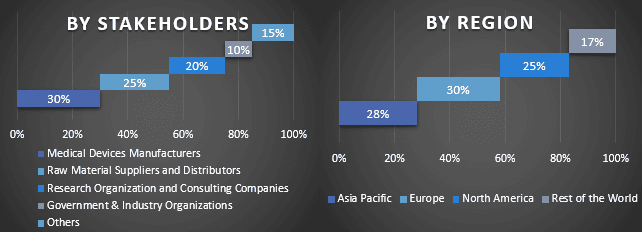
Kỹ Thuật Thị Trường
Kỹ thuật phân tích dữ liệu đã được sử dụng để hoàn thành việc ước tính thị trường tổng thể và để đạt được các số liệu thống kê chính xác cho từng phân khúc và phân khúc con của thị trường thiết bị kiểm tra khả năng sinh sản toàn cầu. Dữ liệu đã được chia thành một số phân khúc & phân khúc con sau khi nghiên cứu các thông số và xu hướng khác nhau trong các lĩnh vực sản phẩm, phương thức mua hàng, ứng dụng và người dùng cuối trong thị trường thiết bị kiểm tra khả năng sinh sản toàn cầu.
Mục tiêu chính của Nghiên Cứu Thị Trường Thiết Bị Kiểm Tra Khả Năng Sinh Sản Toàn Cầu
Các xu hướng thị trường hiện tại & tương lai của thị trường thiết bị kiểm tra khả năng sinh sản toàn cầu đã được xác định chính xác trong nghiên cứu. Các nhà đầu tư có thể thu được những hiểu biết chiến lược để dựa vào sự thận trọng của họ đối với các khoản đầu tư dựa trên phân tích định tính và định lượng được thực hiện trong nghiên cứu. Các xu hướng thị trường hiện tại và tương lai xác định sức hấp dẫn tổng thể của thị trường ở cấp độ khu vực, cung cấp một nền tảng cho người tham gia công nghiệp khai thác thị trường chưa được khai thác để hưởng lợi từ lợi thế của người đi đầu. Các mục tiêu định lượng khác của các nghiên cứu bao gồm:
- Phân tích quy mô thị trường hiện tại và dự báo của thị trường thiết bị kiểm tra khả năng sinh sản về giá trị (USD). Ngoài ra, phân tích quy mô thị trường hiện tại và dự báo của các phân khúc và phân khúc con khác nhau
- Các phân khúc trong nghiên cứu bao gồm các lĩnh vực sản phẩm, phương thức mua hàng, ứng dụng và người dùng cuối.
- Xác định và phân tích khuôn khổ pháp lý cho các thiết bị kiểm tra khả năng sinh sản
- Phân tích chuỗi giá trị liên quan đến sự hiện diện của các trung gian khác nhau, cùng với việc phân tích hành vi của khách hàng và đối thủ cạnh tranh của ngành.
- Phân tích quy mô thị trường hiện tại và dự báo của thị trường thiết bị kiểm tra khả năng sinh sản cho khu vực chính.
- Các quốc gia lớn của khu vực được nghiên cứu trong báo cáo bao gồm Châu Á Thái Bình Dương, Châu Âu, Bắc Mỹ và Phần còn lại của Thế giới.
- Hồ sơ công ty của thị trường thiết bị kiểm tra khả năng sinh sản và các chiến lược tăng trưởng được các công ty tham gia thị trường áp dụng để duy trì trên thị trường đang phát triển nhanh chóng
- Phân tích chuyên sâu ở cấp độ khu vực của ngành
Liên quan Báo cáo
Khách hàng đã mua mặt hàng này cũng đã mua





